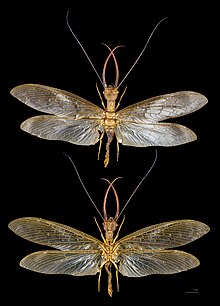Corydalus cornutus
| Corydalus cornutus | |
|---|---|
 |
|
| Mounted male specimen | |
| Scientific classification | |
| Kingdom: | Animalia |
| Phylum: | Arthropoda |
| Class: | Insecta |
| Order: | Megaloptera |
| Family: | Corydalidae |
| Subfamily: | Corydalinae |
| Genus: | Corydalus |
| Species: | C. cornutus |
| Binomial name | |
|
Corydalus cornutus Linnaeus, 1758 |
|
| Synonyms | |
|
|
The eastern dobsonfly, Corydalus cornutus, is a large insect in the Corydalidae family. It is found in eastern North America in regions with fast-flowing streams where its aquatic larvae develop. These are known as hellgrammites and are among the top invertebrate predators in the streams in which they live. They are used by anglers as bait.
The dobsonfly is found in most of eastern North America. It is usually found near the swift flowing, unpolluted streams in which its larvae develop.
The eggs are grey and cylindrical, about 1.4 millimetres long and 0.5 millimetres wide. They are laid in groups of about 1,000, stacked in three layers. The pile of eggs is protected by a clear fluid which dries white and is applied by the female with the tip of her abdomen. The egg mass is said to look rather like a bird dropping.
The larvae are light brown with a covering of tiny dark brown microspines. The thorax has three pairs of legs and each segment is covered by a tough, dark-coloured dorsal plate. The first eight abdominal segments have lateral tactile filaments and the first seven have tracheal gills in tufts. The larvae also have spiracles allowing them to breathe on land as well as in the water. At the tip of the abdomen there are two prolegs, each with a dorsal filament and a pair of terminal hooks which enables the larva to anchor itself in fast-flowing water. The mandibles are sclerotised and powerful.
The pupae are orange in colour with dark patches on the upper side of the abdomen and are covered with minute bristles. The developing limbs, wings and antennae project outside the pupal covering.
The adult dobsonfly is a large insect up to 140 millimetres long with a wingspan of up to 125 millimetres. The female has short powerful mandibles of a similar size to those of the larva while the mandibles of the male are sickle-shaped and up to 40 millimetres long, half as long as the body. The antennae are long and segmented and the greyish translucent, many veined wings are often mottled with white dots. When at rest the wings are folded flat over the insect's back and extend beyond the abdomen.
...
Wikipedia
